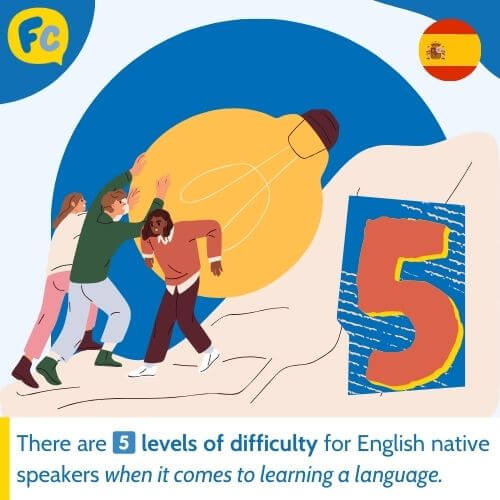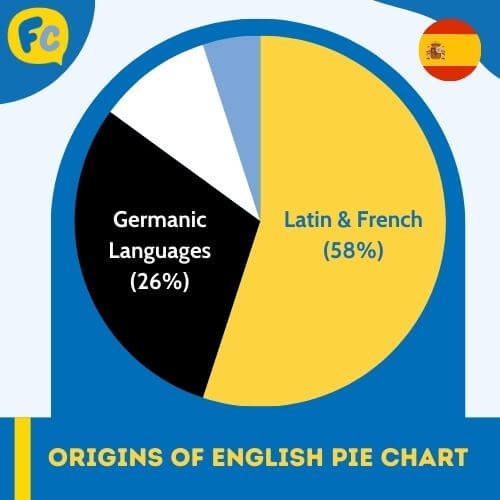How Long Does It Take To Learn Spanish? // The REAL Answer
How Difficulty Levels, Classroom Hours and Knowing English All Affect How Long It Takes to Learn Spanish
📚 While there is no “one shoe fits all” timeline for learning Spanish, as each learner is different and is obviously faced with unique learning challenges and advantages.

Factors like having a similar native language to Spanish, the chance of full immersion, and the learning methods used can either enhance or accelerate one’s learning curve. Alternatively, they can also stagnate it.
🏫 Irrespective of all the possible variables, there are some standard guidelines based on years of gathered empirical data.
These guidelines indicate how long an English native speaker can take to learn a certain language, in this case, Spanish.
Let’s sort through the information so it’s easier to structure your learning journey and manage your expectations and travel agendas to Spain.
Streamline your learning journey and
set realistic expectations to achieve Spanish!
How Long Does It Take To Learn Spanish || Spanish Learning Difficulty Level
How Long Does It Take To Learn Spanish || Why English Is Actually a Plus for Learning Spanish
How Long Does It Take To Learn Spanish || How Many Weeks in the Classroom?
How Long Does It Take To Learn Spanish || Let’s Accelerate the Learning Curve
How Long Does It Take To Learn Spanish || FAQs
How Long Does It Take To Learn Spanish ||
Spanish Learning Difficulty Level
🧐 You asked, we deliver.
The institution known as the Foreign Service Institute (Dependent on the US Department of State), renowned for its language training programs, has long since established a language difficulty ranking.
This ranking is an indication of how long a native English speaker would need to hit what is called “Professional Working Proficiency” level in 60➕ classified languages, among them Spanish.
According to this ranking, formally referred to as the “Foreign Service Institute Language Difficulty Rankings”, there are 5️⃣ levels of difficulty for English native speakers when it comes to learning a language.

These levels of difficulty are categorized into five groups that range from easy languages similar to English to super-hard languages.
Now where is Spanish within the classification? It’s actually in the easiest category (Category I), where the bulk of the Romance languages are thrown in!
💭 Additional information: What exactly is “Professional Working Proficiency” level?
Well, that would equate to a Level 3 on the Interagency Language Roundtable scale or roughly equal to B2/C1 in the Common European Framework of Reference for Languages.
Basically, at a level wherein you can engage effectively in most conversations on a wide array of topics, hence, have a broad enough vocabulary and considerably complete comprehension skills.
🌎 Learning other languages? Find out How Long It Takes to Learn Japanese and How Long It Takes to Learn Korean
How Long Does It Take To Learn Spanish ||
Why English Is Actually a Plus for Learning Spanish
Contrary to the general belief that English as a Germanic language (yup, that’s the official classification folks) would make learning Spanish (a Romance language) much harder to learn, the reverse is actually the case.
📚 Let’s debunk the myth further, English, as academics have proven time and again, has far more similarities in terms of its core vocabulary with words of Romance origin (Latin derived) than of Germanic origin. A shocker!
Also, both languages have significant grammatical similarities, such as sharing the Latin alphabet and following the same basic sentence structure (subject+verb+object), further contributing to making learning Spanish relatively easy for native English speakers.
Origins of English Pie Chart

In the chart, you can see how English words derived from Latin and French (also a Romance language) are more than the words of Germanic origin.
In case you’re wondering, Romance languages include Spanish, French, Italian, Portuguese and Romanian.
💡So, you would have to agree that having a substantial amount of core English vocabulary words that originate from Romance languages definitely facilitates learning Spanish.
Additionally, significant grammatical similarities between the two languages support this process, not the reverse.
How Long Does It Take to Learn Spanish ||
How Many Weeks in the Classroom?
🧐 Going back to the Foreign Service Institute’s categorization on the difficulty of learning languages for English native speakers. We’ve already established that Spanish is ranked among the easiest languages to learn (again, for a native English speaker).
But what does that actually translate to
in terms of hours of effective study to learn Spanish?
Well, it is estimated that, on average, it will take a native English speaker 3️⃣ 0️⃣ weeks, equivalent to 600-750 classroom hours, to learn Spanish at a General Professional Proficiency Level.
Obviously, the time frame is an estimation that can oscillate based on a wide range of variables, such as the degree of active learning and the dedication (time spent and participation in the classroom) of the learner, prior knowledge of other languages, etc. (Source image)
How Long Does It Take to Learn Spanish ||
Let’s Accelerate the Learning Curve
Here are some best practices to accelerate your Spanish learning curve.👇
💡 Consistency
It’s no secret that consistency is key to anything and, specifically applied to learning a language (Spanish in this case) is crucial. Commit to dedicating daily a specific and realistic amount of time (even if only 15 minutes) to learning Spanish.
💡 Immersion
In as much as possible, immerse yourself in Spanish material regularly (watch Spanish movies, videos, shows, listen to Spanish podcasts, read Spanish books, news, etc.), and watch your confidence and fluency soar.
💡 Active learning
Practice active learning while in the classroom versus passive learning or just listening to a lecture. It has been proven time and time again that one has a higher retention rate in learning when done actively, so participate in discussions, practice often, and put what you learn to immediate use.
Study time. Complement your classes with actual study time so you can more fully integrate and expand on what you’ve learned in class. This best practice is frequently overlooked and is key to progress at a faster pace.
💡 Practice makes perfect.
Keep your fluency levels in check and practice speaking, writing and reading Spanish regularly. That way, you not only maintain and expand your vocabulary but keep your Spanish memory from regressing as well.

📌 Get tech-savvy.
Leverage all the technological resources available out there to your advantage.
As an example, use learning apps like Duolingo, Babbel, etc. to support your Spanish learning journey.
👉 Don’t forget to check out our Flexi Classes & our Spanish Blog
- Clothing and Accessories in Spanish: Vocab From Head to Toe
- Top 10 Easy Spanish Songs for Learners
- Fruits and Vegetables in Spanish: Essential Vocabulary
- How to Use ‘Y’ in Spanish: Simple Rules & When to Use ‘E’
- How to Ask and Answer ‘How Are You?’ in Spanish: A Simple Guide
How Long Does It Take To Learn Spanish || FAQs
What are the Category 1 languages in the Foreign Service Institute (FSI) ?
Category I languages are those that are ranked by the FSI as the easiest languages to learn for a native English speaker and are comprised of the following:
(Source image: https://www.fsi-language-courses.org/blog/fsi-language-difficulty/)
How long does it take to learn Spanish?
The Foreign Service Institute (renowned for its language training programs) estimates that, on average, it will take a native English speaker 30 weeks (equivalent to 600-750 classroom hours) to learn a General Professional Proficiency Level Spanish.
Note that these are just estimations that can oscillate based on a wide range of variables, such as the degree of active learning and the dedication (time spent and participation in the classroom) of the learner, prior knowledge of other languages, etc.
Is Spanish easy to learn?
Yes. The institution known as the Foreign Service Institute (Dependent on the US Department of State), ranked the level of difficulty of learning Spanish by a native English speaker as within the easiest group of languages to learn (Category I).
Contributing to the easier level of learning by a native English speaker is the fact that English has significant similarities in key grammatical aspects to Spanish as well as similarities in its core vocabulary to Romance languages (Spanish being one of them).
Is Spanish grammar the same as English?
While there are undeniable differences between Spanish and English, both also have significant similarities in grammar and core vocabulary than one would expect, making learning Spanish significantly easier for an English native speaker.
For starters, academically it has been proven that English (officially classified as a Germanic language) has far more similarities in terms of its core vocabulary with words of Romance origin (Spanish among them) than those of Germanic origin.
Also, some significant grammatical similarities between the two languages include sharing the Latin alphabet and following the same basic sentence structure (subject+verb+object).
How to learn Spanish fluently?
Consistency: Dedicate a realistic daily time (even 15 minutes) to learning.
Immersion: Engage with Spanish media—movies, podcasts, and books—to boost confidence and fluency.
Active Learning: Participate in discussions and practice actively during classes.
Study Time: Supplement classes with dedicated study sessions to reinforce learning.
Practice: Regularly speak, write, and read in Spanish to maintain fluency.
Tech-Savvy: Use apps like Duolingo or Babbel to enhance your learning and motivation.
Want More From LTL?
FANCY LEARNING SPANISH? Check out our online Spanish courses here.
We offer a 7-day free trial to all online students where you can study Spanish 24/7. It doesn’t end there either.
We teach over 10 of the world’s most popular languages 😎
Come and be a part of our amazing community.









